Rizkan Chandra, President Director, Semen Indonesia: Interview

Interview: Rizkan Chandra
What is the outlook for the cement sector?
RIZKAN CHANDRA: In 2015 we saw a new era for the cement industry in Indonesia. There have been two important issues regarding cement. The first was the beginning of overcapacity for the industry, and the second was the 2.4% decline in cement prices. Those trends have continued into 2016 and will likely remain the same for the next couple of years. Usually cement growth is similar to GDP growth, and in 2015, although GDP growth was around 5%, cement growth was only around 1%. Given a further price decline, we do not expect to have growth of 5% in 2016. We believe that due to the industry’s margin on higher earnings before interest, taxes, depreciation and amortisation (EBITDA) compared to the region, and with fewer regulations, many players will move to Indonesia until the margin is not appealing anymore. The average EBITDA margin in the region is about 15-20%, while in Indonesia the average is 26%.
Do you see potential for regional expansion among Indonesian cement companies?
CHANDRA: We see the market not as an Indonesian market but as a regional market. The opportunities can be the same whether it is in Makassar or Bangkok. But the regional Asian market is already crowded and at overcapacity because of oversupply in China, among other reasons. However, it is important to select these markets according to three main criteria: close proximity to our facilities in Indonesia, a lack of raw materials and favourable market structure, and it being an oligopoly. In that way, we see that our production capacity is meant not only for Indonesia, but also for the region as a whole, and the other way around. For example, our facility in Vietnam can provide cement to the north of Indonesia when they are in overcapacity. So it is about how to see the balance of supply and demand in the region. This will certainly help lower the challenge of overcapacity in Indonesia.
How can Indonesian companies improve their competitiveness in the region?
CHANDRA: Other than our regional expansion, we need to create self-defence mechanisms in the domestic market by complying with new capital expenditures, new operational expenditures, new standard operation procedures and new technologies. But this will not be enough since that will incur lower revenue, lower EBITDA and lower net income. So we have to go downstream. In more developed countries, everything has moved from raw materials to more prefabricated materials. Cement is now considered prefabricated, but as time goes by the definition of what prefabricated is will change. That is why we are going to go downstream. In that way, we will not only absorb the cement, but also create new value and a new market. In a world of overcapacity consolidation, this will be the next logical step for the Indonesian cement market.
To what extent can government infrastructure projects drive growth for the sector?
CHANDRA: Government infrastructure projects are and will be the main driver for the industry, whether it is for retail or property. Properties always look to the government for a signal to see if the year is good or not. This administration has been in place for around two years. In its first year, restructuring took too much time. That is the main reason why infrastructure development was not fast enough in 2015. Now things are moving faster, and this has been improved by macro-economic conditions. For example, tax amnesty has been approved, the central bank has lowered rates and liquidity is quite high. The loan-to-value ratio has also been reduced, so this will stimulate not only infrastructure projects, but also properties. We hope that during the second half of 2016 the disbursement and execution of projects will be further accelerated and that this keeps on going.
You have reached the limit of premium articles you can view for free.
Choose from the options below to purchase print or digital editions of our Reports. You can also purchase a website subscription giving you unlimited access to all of our Reports online for 12 months.
If you have already purchased this Report or have a website subscription, please login to continue.

